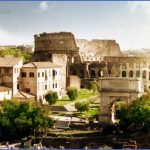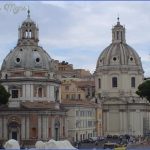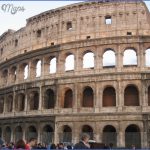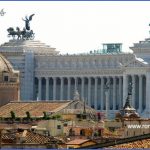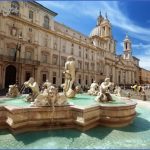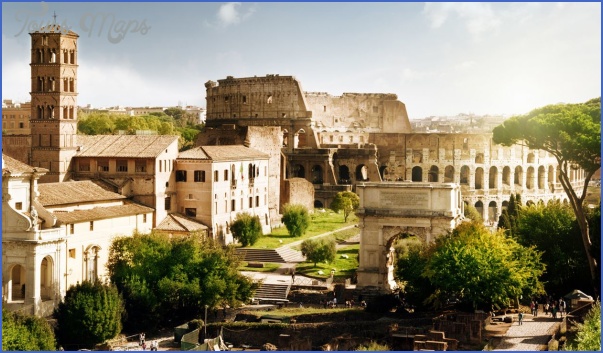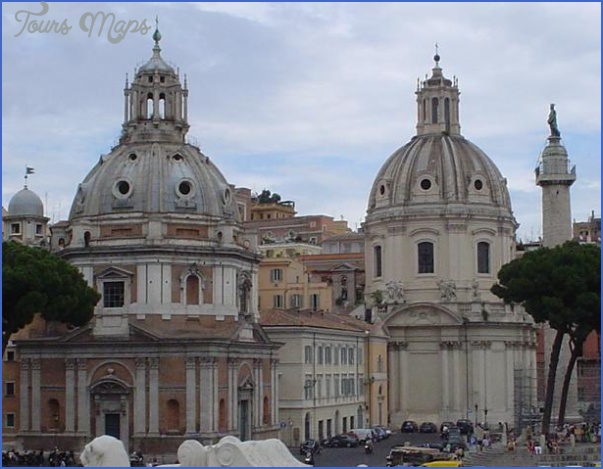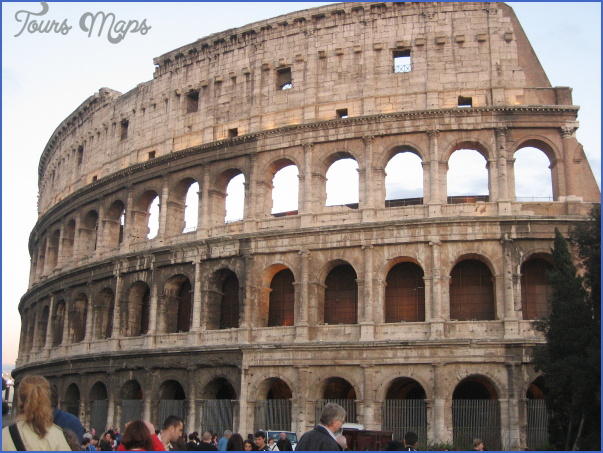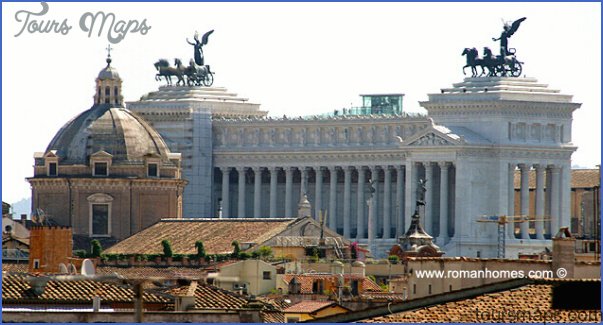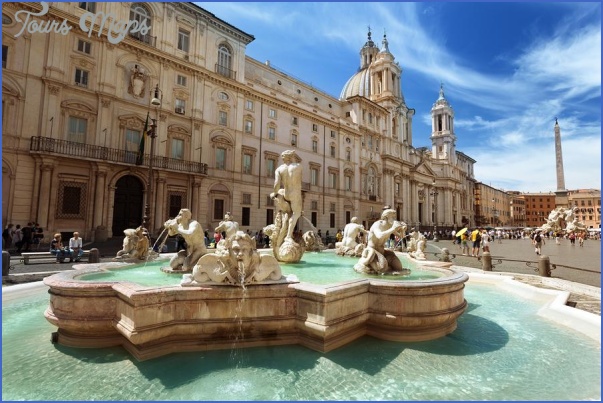SIGHTS of ROME
Rome wasn’t built in a day, and it’s not likely that you’ll see any substantial portion of it in twenty-four hours, either. Ancient temples and forums, Renaissance basilicas, 280 fountains, and 981 churches there’s a reason, according to Robert Browning, that everyone sooner or later comes round by Rome.
ANCIENT CITY
What Rome lacks in a downtown it more than makes up for in ruins the downtown Cicero and Catullus knew. The Umbilicus Urbis, literally navel of the world, marked the center of the known universe. And who said Romans were egocentric?
ROMAN FORUM. Here, the pre-Romans founded a thatched-hut shantytown in 753 BC. The entrance ramp leads to V. Sacra, Rome’s oldest street, near the Basilica Aemilia, built in 179 BC, and the area once known as the Civic Forum. Next to the Basilica stands the Curia (Senate House); it was converted to a church in AD 630 and restored by Mussolini. The broad space in front of the Curia was the Comitium, where male citizens came to vote and representatives of the people gathered for public discussion. Bordering the Comitium is the large brick Rostrum (speaker’s platform) erected by Julius Caesar in 44 BC, just before his death. The hefty Arch of Septimius Severus, to the right of the Rostrum, was dedicated in AD 203 to celebrate Caesar’s victories in the Middle East. The market square holds a number of shrines and sacred precincts, including the Lapis Niger (Black Stone), where Romulus was supposedly murdered by Republican senators. Below the Lapis Niger are the underground ruins of a 6th- century BC altar and the oldest known Latin inscription in Rome. In the square, the Three Sacred Trees of Rome olive, fig, and grape have been replanted by the Italian state. The newest part of the Forum is the Column of Phocas, erected in AD 608. The three great temples of the Lower Forum have been closed off for excavations; however, the eight columns of the 5th-century BC Temple of Saturn, next to the Rostrum, have been restored. Around the comer, rows of column bases are all that remain of the Basilica Julia, a courthouse built by Julius Caesar in 54 BC. At the far end, three marble columns mark the massive podium of the recently restored Temple of Castor and Pollux, built to celebrate the Roman defeat of the Etruscans. The circular building is the Temple of Vesta, where Vestal Virgins tended the city’s sacred fire, keeping it lit for more than a thousand years.
In the Upper Forum lies the House of the Vestal Virgins. For 30 years, the six virgins who officiated over Vesta’s rites lived in seclusion here from the ripe old age of seven. Near here, V. Sacra runs over the Cloaca Maxima, the ancient sewer that still drains water from the otherwise marsh-like valley. V. Sacra continues out of the Forum proper to the Velia and the gargantuan Basilica of Maxentius. The middle apse of the basilica once contained a gigantic statue of Constantine with a bronze body and marble head, legs, and arms. The uncovered remains, including a 2m foot, are displayed at the Palazzo dei Conservatori on the Capitoline Hill (647). V. Sacra leads to an exit on the other side of the hill to the Colosseum; the path that crosses before the Arch of Titus heads to the Palatine Hill. (M: B-Colosseo, or bus to P. Venezia. Main entrance is on V.d. Fori Imperiali, at Largo C. Ricci, between P. Venezia and the Colosseum. Open in summer daily 9am-6:30pm; off-season daily 9am-3:30pm. Guided tour ‚3.50; audioguide in English, French, German, Italian, Japanese, or Spanish; ‚4.)
THE PALATINE HILL. The best way to attack the Palatine is from the stairs near the Forum’s Arch of Titus. Throughout the garden complex, terraces provide breathtaking views. Farther down, excavations continue on the 9th-century BC village, the Casa di Romulo. To the right of the village is the podium of the 191 BC Temple of Cybele. The stairs to the left lead to the House of Livia, which is connected to the House of Augustus next door. Around the corner, the long, spooky Cryptoporticus connected Tiberius’s palace with the buildings nearby. The path around the House of Augustus leads to the vast ruins of a giant palace and is divided into two wings. The solemn Domus Augustana was the private space for the emperors; the adjacent wing, the sprawling Domus Flavia, once held a gigantic octagonal fountain. Between the Domus Augustana and the Domus Flavia stands the Palatine Antiquarium, the museum that houses the artifacts found during the excavations of the Palatine Hill. (30 people admitted every 20min. starting at 9:10am. Free.) Outside on the right, the palace’s east wing contains the curious Stadium of Domitian, or Hippodrome, a sunken oval space once surrounded by a colonnade but now decorated with fragments of porticoes, statues, and fountains. The Arch of Constantine lies between the Colosseum and the Palatine Hill, marking the tail end of the V. Sacra. One of the best-preserved monuments in the area, it commemorates Constantine’s victory over Maxentius at the Milvian Bridge in AD 315. (The Palatine rises to the south of the Forum. Open in summer daily 9am-7:15pm; off-season 9am-4pm; sometimes closes M-F 3pm, Su and holidays noon. Ticket to the Palatine Hill and the Colosseum ‚8. 7-day ticket book good for entrance to the 4 Musei Nazionali Romani, the Colosseum, the Palatine Hill, the Terme di Diocieziano, and the Crypti Balbi; ‚20.)
FORI IMPERIALI. Across the street from the Ancient Forum are the Fori Imperi- ali, a conglomeration of temples, basilicas, and public squares constructed in the first and second centuries. Excavations will proceed through 2003, so the area is closed off, but you can still get free views by peering over the railing from V.d. Fori Imperiali or V. Alessandrina. Built between AD 107 and 113, the Forum of Trajan included a colossal equestrian statue of Trajan and an immense triumphal arch. At one end of the now-decimated forum, 2500 carved legionnaires march their way up the almost perfectly preserved Trajan’s Column, one of the greatest extant specimens of Roman relief-sculpture. The crowning statue is St. Peter, who replaced Trajan in 1588. The gray tufa wall of the Forum of Augustus commemorates Augustus’s victory over Caesar’s murderers in 42 BC. The aptly named Forum Transitorium (also called the Forum of Nerva) was a narrow, rectangular space connecting the Forum of Augustus with the Republican Roman Forum. The only remnant of Vespatian’s Forum is the mosaic-filled Church of Santi Cosma e Damiano across V. Cavour, near the Roman Forum. (Open daily 9am-6:30pm.)
THE COLOSSEUM. This enduring symbol of the Eternal City a hollowed-out ghost of marble that dwarfs every other ruin in Rome once held as many as 50,000 spectators. Within 100 days of its opening in AD 80, some 5000 wild beasts perished in the arena (from the Latin word for sand, harena, which was put on the floor to absorb blood). The floor (now partially restored) covers a labyrinth of brick cells, ramps, and elevators used to transport wild animals from cages up to arena level. Beware the men dressed as gladiators: They want to take a picture with you for ‚5. (M: B-Colosseo. Open May-Oct. daily 9am-6:30pm; Nov.-Apr. 9am-4pm.)
DOMUS AUREA. This park houses just a portion of Nero’s Golden House, which once covered a huge chunk of Rome. After deciding that he was a god, Nero had architects build a house worthy of his divinity. The Forum was reduced to a vestibule of the palace; Nero crowned it with the 35m Colossus, a huge statue of himself as the sun. (On the Oppian Hill. From the Colosseum, walk up V.d. Domus Aurea and make the 1st left. Reservations 06 39 96 77 00. Open M and lV-Su 9am- 7:45pm. Groups of 30 admitted every 20min. ‚5.)
VELABRUM. The Velabrum is a flat flood plain south of the Jewish Ghetto. At the bend of V. del Portico d’Ottavia, a shattered pediment and a few ivy-covered columns are all that remain of the once magnificent Portico d’Ottavia. The stocky, gray Teatro di Marcello next door is named for Augustus’s nephew, whose early and sudden death remains a mystery. Farther down V. di Teatro di Marcello, Chiesa di San Nicola in Carcere incorporates three Roman temples originally dedicated to Juno, Janus, and Spes. (s06 686 99 72. Open Sept.-July M-Sa 7:30am-noon and 4-7pm.) Across the street, the Chiesa di Santa Maria in Cosmedin harbors some of Rome’s most beautiful medieval decorations. The Audrey Hepburn film Roman Holiday made the portico’s relief, the ElBocca della Verity, famous; according to legend, the hoary face will chomp on the hand of a liar. (Open daily lOam-lpm and 3-7pm. Portico open daily 9am-7pm.)
CAPITOLINE HILL. Home to the original capital, the Monte Capitolino still serves as the seat of the city government. Michelangelo designed its Piazza di Campidoglio, now home to the Capitoline Museums (653). Stairs lead up to the rear of the 7th- century Chiesa di Santa Maria in Aracoeli. The gloomy Mamertine Prison, consecrated the Church of San Pietro in Carcere, lies down the hill from the back stairs of the Aracoeli. Saint Peter, imprisoned here, baptized his captors with the waters that flooded his cell. (Open daily 9am-12:30pm and 2:30-6:30pm. Donation requested.) At the far end of the piazza, opposite the stairs, lies the turreted Palazzo dei Senatori, the home of Rome’s mayor. (To get to the Campidoglio, take any bus that goes to P. Venezia. From P. Venezia, walk around to the right to P. d’Aracoeli, and take the stairs up the hill.)
SIGHTS of ROME Photo Gallery
Maybe You Like Them Too
- Explore Sasbach, Germany with our Interactive Map
- Explore Nevestino, Bulgaria with this Detailed Map
- Explore Pulau Sebang Malaysia with this Detailed Map
- Explore Southgate, Michigan with this detailed map
- Explore Les Accates, France with this Detailed Map

